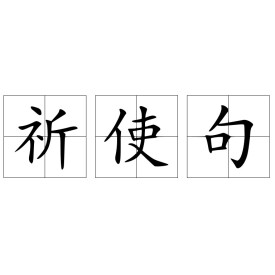共找到2條詞條名為祈使句的結果 展開
- 中文祈使句
- 英語祈使句
祈使句
英語祈使句
祈使句(Imperative Sentence)是英語中的一個句式,也是用於表達命令、請求、勸告、警告、禁止等的句子。祈使句最常用於表達命令,因此在學校文法中也常稱為命令句。
1.肯定的祈使句結構
(1)be+形容詞/名詞
例:Be quiet for a moment.請安靜一會
(2)實義動詞原形+其他成分
例:Make your own rules.給自己制定規劃
(3)let+賓語+動詞原形+其他
例:Let's run to the police station on fourth street.我們跑去第四大街上的警察局吧
2.否定句的祈使句的結構
(1)Don't+動詞原形
例:Don't eat in the classroom.不要在教室里吃東西
(2)Let's+ not+動詞原形
例:Let's not say anything about it.對於這件事,咱們什麼也不要說
(3)用否定副詞never構成,以加強否定含義
例:Never judge a person by looks.絕不能以貌取人
祈使句(Imperative Sentence)用於表達命令、請求、勸告、警告、禁止等句子叫做祈使句,祈使句最常用於表達命令,因此在學校文法中也常稱為命令句。
例:
• Go and wash your hands.(去洗你的手。——命令)
• Be quiet,please.(Please be quiet.)(請安靜。——請求)
• Be kind to our sister.(對姊妹要和善。——勸告)
• Watch your steps.(走路小心。——警告)
• Look out!Danger!(小心!危險!——強烈警告,已如感嘆句)
• Keep off the grass.(勿踐草坪。——禁止)
• No parking.(禁止停車。——禁止)
• No eating or drinking.(禁止吃喝。——禁止)
• No littering.(禁止亂扔垃圾。——禁止)
祈使句也常把主語“You”表達出來,主要是強調對象,確定對象。
例如:
You go and tell him, kris. (克立斯去告訴他。)
祈使句無主語,主語you常省去;
動詞原形當謂語,Don't句首變否定;
朗讀應當用降調,句末常標感嘆號。
肯定結構
1.Do型(即:動詞原形(+賓語)+其它成分)。如:Please have a seat here. 請這邊坐。
有的祈使句在意思明確的情況下,動詞可省略。如:This way,please. = Go this way,please. 請這邊走。
2.Be型(即:Be +表語(名詞或形容詞)+其它成分)。如:Be a good child! 要做一個好孩子!
3.Let型(即:Let + 賓語 + 動詞原形 + 其它成分)。如:Let me help you. 讓我來幫你。
否定結構
1.Do型和Be型的否定式都是在句首加don't構成:如: Don't forget me! 不要忘記我! Don't make such a noise.不要這麼吵。 Don't be late for school! 上學不要遲到!(是系表結構——也就是沒有行為動詞但是有形容詞的那種——就可以使用Don't be,有行為動詞的就不能這麼用,只能用Don't。)
2.Let型的否定式有兩種:“Don't + let +賓語+動詞原形+ 其它成分”和“Let + 賓語 + not + 動詞原形 + 其它成分”。如:Don't let him go. / Let him not go. 別讓他走。
3.有些可用no開頭,用來表示禁止性的祈使句。如:No smoking! 禁止吸煙!No fishing! 禁止釣魚!
肯定的祈使句
a.句型:動詞原形~.(含有第二人稱主語的祈使句,省略主語)
Stand up.起立。
Be quiet,please.請安靜。
Be careful!小心!
b.有時,為了加強語氣,可以在動詞之前加do
Do sit down.務必請坐。
Do study hard.一定要努力學習。
c.用客氣的語氣表示祈使句時,可在句首或句尾加上please,但如果在句尾加please,那在please之前一定要加一個逗號“,”。
Go this way,please.請這邊走。
d.祈使句中如果有喚語,一定要用逗號“,”隔開,放在句首或句尾。
Li Ming,come here.李明,過來。
Come here,Li Ming.過來,李明。
e.祈使句和陳述句比較:
陳述句:You sit down.你坐下來。
祈使句:Sit down.坐下(省略主語you)
否定的祈使句
句型:Don't / Never+動詞原形~
• Don't swim in the river.別在河裡游泳。
• Don't be late.別遲到。
• Please don't be noisy.請不要大聲喧嘩。
• Never answer the phone while driving. 決不在開車的時候接電話。
表示禁止
表示禁止時,尤其是標語等也可用“No+名詞/動名詞”來表示。
• No smoking!禁止吸煙!
• No parking!禁止停車!
• No entry!不準入內!
• No litter!不準亂扔雜物!
句型:·Let+第一人稱(me,us)~.
·Let+第三人稱代詞(賓格:him,her,it,them)或名詞~.
Let's go at once.咱們馬上動身吧。
Let me try again.讓我再試試。
Let Tom go there himself.讓湯姆自己去那兒。
注意
Let's包括對方,Let us不包括對方。反意疑問句時最明顯。
Let's go,shall we?咱們去吧,怎麼樣?
Let us go,will you?讓我們去吧,行嗎?(徵求對方的意見)
由"let"帶頭的祈使句(Imperative Sentences)是個常見的動詞句型,它的主要用法有下列三種:
(1)表示“建議”。
這個句型里的"let"後頭緊跟著一個第一人稱的代詞賓語。
如:
Let me try.
Let's do it.
Let me go and look for it.
這個句型語氣委婉,比直接的祈使句客氣。試比較以下a和b句:
a. Don't disturb him.
b. Let's not disturb him.
(a)是直接命令,語氣強烈,不如(b)溫柔悅耳。
(2)表示“間接命令”或“願望”。
這句型里的動詞賓語是第三人稱名詞或代詞。
如:
Let Robert take charge of the marketing department.
Let her join our choir.
(3)表示“警告”、“蔑視”、“威脅”等。
這種祈使句里的賓語也是第三人稱為主。除了口氣兇悍之外,有時還語帶諷刺。
如:
Let him try and he will expose his inability to work on his own.
Let the invaders come and our armed forces will wipe them out in no time.
句型:·Let‘s(us,me)+not +動詞原形~.
·Don’t let +第三人稱代詞的賓格或名詞+動詞原形.
Let's not say anything about it.
對於這件事,咱們什麼也不要說。
Don't let them play with fire.
別讓他們玩火。
用"let"的祈使句時,必須注意下列幾點:
(1)如果賓語是第三人稱用"Don't let....."(見例(c));如果賓語是第一人稱,則用"Let......not" (見例(d)):
c. Don't let this type of things happen again.
d. It's rainingnow. Let's not go out until after the rain.
(2)"Let"只適用於現在時,可以有被動語態(the passive voice)。
如:
Let the recalcitrant criminals be sent to prison.
Let all the dedicated capable staff be promoted.
(3)"Let"後頭除了是不帶"to"的不定式動詞 (The infinitive without"to")之外,還可以是某些適當的副詞,如out,in,down,alone等:
Let the puppy out.
Open the windows and let the fresh air in.
The room is too sunny. Let the blinds down.
Let me alone,please.
(4)用"Let's"時,把談話者的對象包括在內;用"Let us"時,並不包括對方。
如:
e. Let's try it,shall we?
f. Let us do it by ourselves,will you?
從(e)里的"shall we"和(f)里的"will you",不難知道前者包括聽話人,後者並沒有。祈使句表示請求、命令、建議等等。謂語動詞一律用原形。句子中通常不用主語,句末用驚嘆號或者句號,用降調。
有時會在句末加“will you"強化預期
例句:
a.Open the door,will you?
b.Don't close the window,will you?
A、祈使句與陳述句的改寫
(1)祈使句=You must …(陳述句)
Come here .過來。=You must come here.你必須過來。
(2)Please +祈使句=Will you (please) ~?(陳述句)
Please help me .請幫幫我。
=Will you (please) help me你願意幫我的忙嗎?
Come here on time,please .請準時到這兒。
=Will you (please) come here on time請你準時到好嗎?
(3)含有第一、第三人稱主語的祈使句
Let‘s say good-bye here.我們在此道別吧。
Don't let him do that again.別讓他再那麼做了..
B、祈使句與條件句
祈使句有時相當一個“if”引導的條件狀語從句。
祈使句:Use your head and you'll find a way.
條件句:If you use your head,you'll find a way.
C、祈使句的反意疑問句形式
(1)Let's表示說話人向對方提出建議,簡短問句的主語用we表示,問句用 shall we或 shan't we。
如:
Let's have a cup of tea,shall we (shan't we)
(2)Let me或 Let us表示聽話人提出請求,問句用 will you或 won't you.
Let me have a rest,will you (won't you )
注意
回答Let's~的反意疑問句句型時,肯定時用Yes,let''s.否定時用NO,let''s not.
(3)其它的祈使句后可以加一個簡短問句,使語氣變得客氣一些.
如:
Have a rest,will you.
Stand up,will (won't) you.
祈使句的分類
祈使句表請求、命令、叮囑、邀請、勸告等。祈使句分為第二人稱祈使句及第—、三人稱祈使句兩大類。
(1)第二人稱祈使句通常用來向聽話者發出命令,提出要求或建議。這種祈使句的主語you通常不表示出來,而是以動詞原形開頭。如:
Stand up!
Don’t worry about!
但如果說話時有多人在場,就得把主語表示出來,或加呼語,以便指明是向誰提出請求或發出命令。如:
Parents with children go the front! 帶孩子的家長到前面去!
Mary clean the windows,and you boys wash the floor! 瑪麗擦窗戶,你們男孩子洗地板!
Come in,everybody! 每個人都進來!
有時將主語表示出來是為了加強語氣或表示“不高興”、“厭煩”、“鄙視”等情緒。如:
Don’t you be late again! 你可別再遲到了!
You get out of here! 你給我滾出去!
Mind your own business,you! 你少管閑事!
(2)第一、三人稱祈使句是以第一人稱和第三人稱代詞或者名詞等作為祈使的對象,這類祈使句通常以let為引導詞表建議。如:
Let’s go! Let us go home!Let him be here by 10 o’clock.
祈使句除用謂語動詞表示外,還可用名詞、副詞、動詞短語等表示。如:
Help!
Patience!
Quickly!
祈使句的強調形式及否定形式
祈使句的強調形式是在整個結構之前加do。如:
Do be careful!
Do Stop talking!
Do give my regards to your parents!務必/一定代我向你父母問好!
祈使句的否定形式在整個結構之前加don’t或never(never的語氣比don't更強烈)。如:
Don'tanswer the phone while driving. 不要在開車的時候接電話。
Never answer the phone while driving. 決不在開車的時候接電話。
以let為引導詞的祈使句的否定形式通常是在Let’s或Let us/me后加not。如:
Let’s not waste our time arguing about it!咱們別浪費時間爭論這事了!
Let’s not say anything about it! 這事咱們誰也別說!
但英式英語也用這樣的表達:Don’t let’s say anything about it
祈使句的反意疑問句
(1)祈使句的反意疑問部分為肯定形式,要用shall,will。如:
Pass me the book,will you?
(2)Let’s表示第一人稱的祈使句,反意疑問句為“Shall we?”。如:
Let’s go for a walk,shall we?
Let’s forget it,shall we?
(3)Let me和Let us 表示第二人稱的祈使句,反意疑問句為“will you?”。如:
Let us go for a walk,will you?
(4)其它行為動詞引起的祈使句,無論其陳述部分是否定還是肯定的祈使句,多用“will you?”,表一種客氣的語氣。如:
Listen to me,will you?Don’t tell anyone about it,will you?
但在肯定的祈使句後有時也用“won’t you?”表“提醒對方注意”或表“邀請”。如:
Have a cup of coffee,won’t you?
Come in and take a seat,won’t you/will you?
祈使句用於兩個重要句型中(重點)
(1)“祈使句+ and+表結果的陳述句”用來敘述肯定的條件。
(2)“祈使句+or+表結果的陳述句”用來敘述否定的條件,or表示“否則;要不然”。試比較:
Hurry up and you’ll catch the train. (=If you hurry up,you’ll catch the train.)
Hurry up,or you’ll miss the train.(=If you don’t hurry up,you’ll miss the train.)
“Speak loudly,please!” the teacher said to me.(=The teacher asked me to speak loudly.)
“Don’t smoke in the meeting room!” he said to Tom.(=He told Tom not to smoke in the meeting room.)
特殊用法
祈使句有時候相當於一個由if 引導的條件狀語從句。
如:
Study harder,and you will catch up with the others in your class.
努力學習些,你會趕上班裡其他同學的。
If you study harder,you will catch up with the others in your class.
如果你學習再努力些,你會趕上班上其他同學的。
